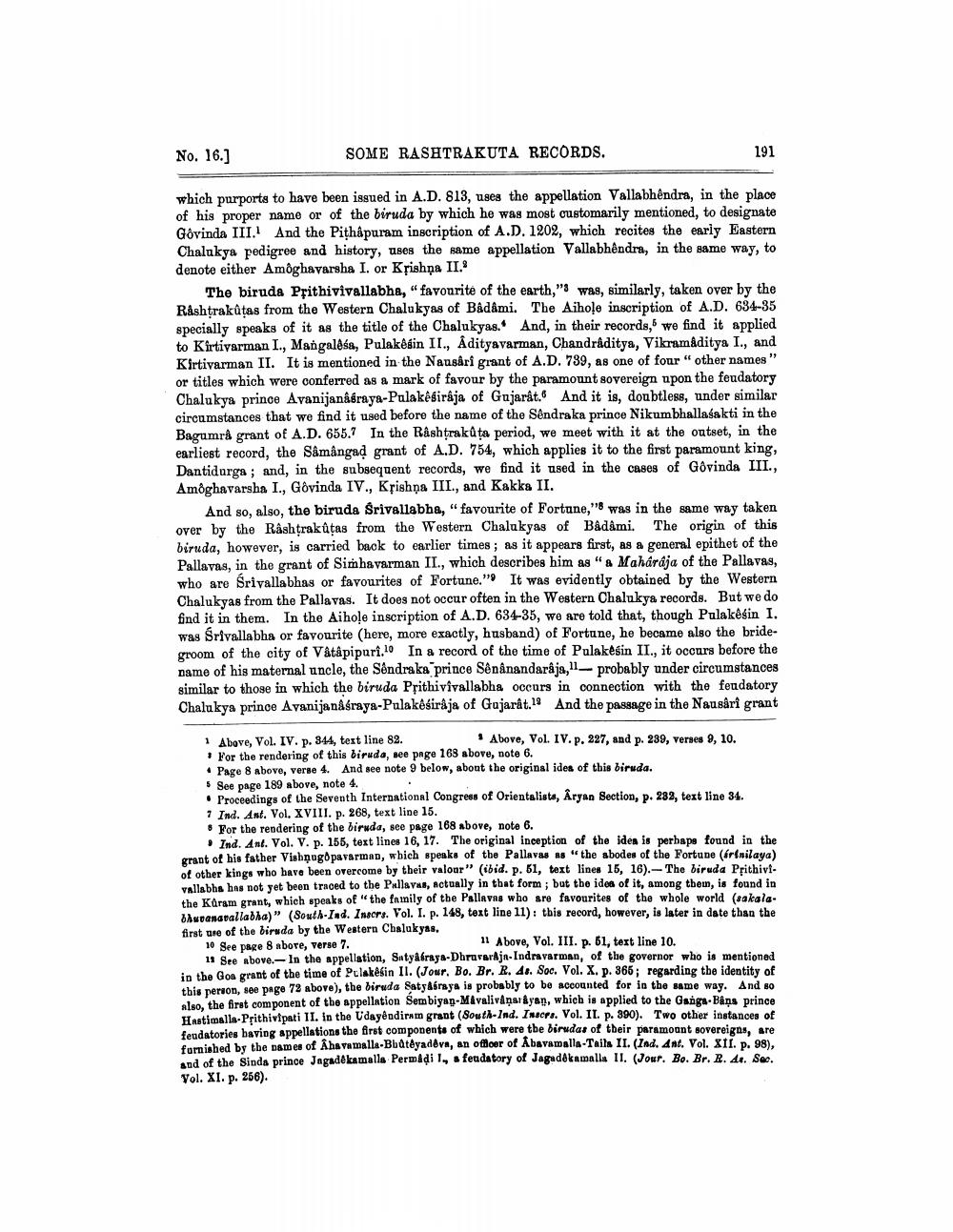________________
No. 16.]
SOME RASHTRAKUTA RECORDS.
191
which purports to have been issued in A.D. 813, uses the appellation Vallabhêndra, in the place of his proper name or of the biruda by which he was most customarily mentioned, to designate Govinda III. And the Pithapuram inscription of A.D. 1202, which recites the early Eastern Chalukya pedigree and history, uses the same appellation Vallabhêndra, in the same way, to denote either Amoghavarsha I. or Krishna II.
The biruda Prithivivallabha, "favourite of the earth," was, similarly, taken over by the Rashtrakūtas from the Western Chalukyas of Bådâmi. The Aihole inscription of A.D. 634-35 specially speaks of it as the title of the Chalukyas. And, in their records, we find it applied to Kirtiyarman I., Mangaldsa, Pulakésin II., Adityavarman, Chandraditya, Vikramaditya I., and Kirtivarman II. It is mentioned in the Nausâri giant of A.D. 739, as one of four "other names" or titles which were conferred as a mark of favour by the paramount sovereign upon the feudatory Chalukya prince Avanijanåfraya-Palakësiraja of Gujarat. And it is, doubtless, under similar circumstances that we find it used before the name of the Sandraka prince Nikumbhallabakti in the Bagumrå grant of A.D. 655.7 In the Rashtrakūta period, we meet with it at the outset, in the earliest record, the Sâmångad grant of A.D. 754, which applies it to the first paramount king, Dantidorga ; and, in the subsequent records, we find it used in the cases of Govinda III., Amoghavarsha I., Govinda IV., Krishna III., and Kakka II.
And so, also, the biruda Śrivallabha, "favourite of Fortune," was in the same way taken over by the Rashtrak utas from the Western Chalukyas of Badami. The origin of this birda, however, is carried back to earlier times; as it appears first, as a general epithet of the Pallavas, in the grant of Simhavarman II., which describes him as "& Maharaja of the Pallavas, who are Srivallabhas or favourites of Fortune." It was evidently obtained by the Western Chalukyas from the Pallavas. It does not occur often in the Western Chalukya records. But we do find it in them. In the Aihole inscription of A.D. 634-35, we are told that, though Pulakesin I. was Srivallabhs or favourite (here, more exactly, husband) of Fortune, he became also the bridegroom of the city of Vatâpipari.lo In a record of the time of Pulakesin II., it occurs before the name of his maternal uncle, the Sêndraka prince Sênânandaraja, 11. probably under circumstances similar to those in which the biruda Prithivivallabha occurs in connection with the feudatory Chalukya prince Avanijanåsraya-Pulakésiraja of Gujarat.18 And the passage in the Nausâri grant
1 Above, Vol. IV. p. 344, text line 82.
Above, Vol. IV. p. 227, and p. 239, verses 9, 10. For the rendering of this biruda, see page 168 above, note 6. • Page 8 above, verse 4. And see note 9 below, about the original ides of this biruda.
See page 189 above, note 4. . • Proceedings of the Seventh International Congress of Orientalista, Aryan Section, p. 283, text line 34. 7 Ind. Ant. Vol. XVIII. p. 268, text line 15. $ For the rendering of the biruda, see page 168 above, note 6.
Ind. Ant. Vol. V. p. 155, text lines 16, 17. The original inception of the idea is perhaps found in the grant of his father Vishnugopavarman, which speaks of the Pallavas as "the sbodes of the Fortune (irfnilaya) of other kings who have been overcome by their valour" (ibid. p. 61, text lines 15, 16). The biruda Prithivf
allabhs has not yet been traced to the Pallayas, actually in that form; but the idea of it, among them, is found in the Kdram grant, which speaks of "the family of the Palleyas who are favourites of the whole world (akala. Bhuvanarallabha)" (South-Ind. Inscrs. Vol. I. p. 148, text line 11): this record, however, is later in date than the first use of the biruda by the Western Chalukyas. 10 See page 8 xbore, verse 7.
11 Above, Vol. III. p. 61, text line 10. 11 See above. In the appellation, Satyaraya-Dhraseraja Indravarman, of the governor who is mentioned in the Goa grant of the time of Pulakekin II. (Jour, Bo. Br. R. 41. Soo. Vol. X. p. 366; regarding the identity of this person, see page 72 above), the biruda Satydórsya is probably to be accounted for in the same way. And so also, the first component of the appellation Sembiyan-Mavalivåņaikyan, which is applied to the Garga-Båns prince Hastimalla-Prithivipati 11. in the Udayêndiram grant (South-Ind. Insom. Vol. IL p. 390). Two other instances of fondatories having appellations the first components of which were the dirudas of their paramount sovereigos, are furnished by the names of Ahavamalla-Bbdtéyadeva, an officer of Abavamalla-Tails II. (Ind. Ant. Vol. XII. p. 98), and of the Sinda prince Jagadékamalla Permadi 1. a feudatory of Jagaddkamalla II. (Jour. Bo. Br. R. 41. Soc. Vol. XI. p. 256).




